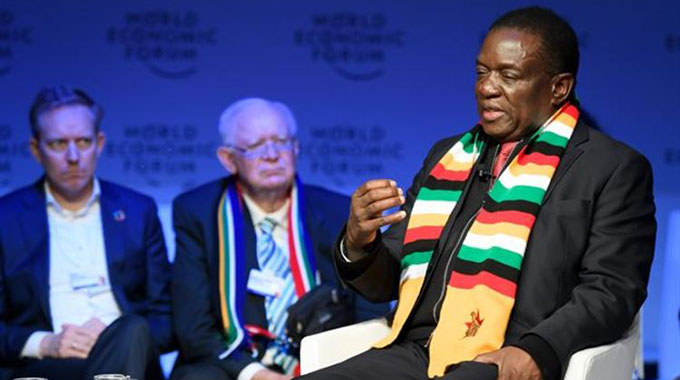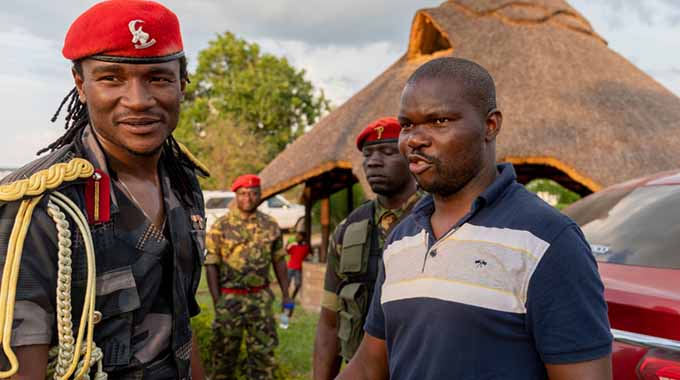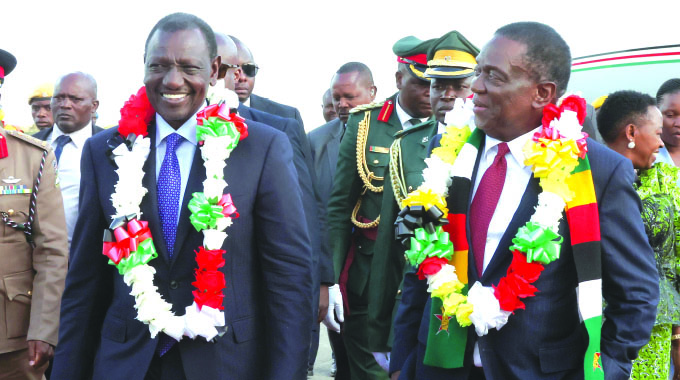A hectic diplomatic 12 months for ED

Felex Share Senior Reporter
After taking over from former president Robert Mugabe in November last year, President Mnangagwa and his team needed to provide strong leadership and put the basic fundamentals in place for the country to take off.
To achieve this, it meant a busy schedule for the President as he had to fulfil varying programmes locally, regionally and internationally.
The year 2018 saw the Head of State and Government launching a diplomatic offensive with his re-engagement thrust and “Zimbabwe is open for business” mantra.
The efforts were not barren as they saw Zimbabwe scoring major successes and attracting investment commitments worth over $15 billion.
This was largely due to the new dispensation’s emphasis on openness, honesty, hard work and complete departure from the scorched earth policies of the previous administration.
To ensure mutual cooperation with countries across the globe, a massive diplomatic offensive needed to be launched.
President Mnangagwa, being a new kid on the block, kicked off the year by paying courtesy calls on Sadc leaders, apprising them on the changes that had taken place in Zimbabwe.
That same month he raised the Zimbabwean flag high, made his first trip outside Africa by attending the World Economic Forum in Davos, Switzerland.
He became the first sitting Zimbabwean president to attend the event.
In Davos, he held fruitful high-level meetings with renowned businesspeople, directors of multilateral institutions and political leaders.
He had fruitful discussions with Swiss leader Allain Berset and made a plea for European countries to consider investments in Zimbabwe.
He also held successful high-level meetings with global businessmen including the United Kingdom-based Swiss billionaire, Urs Shwazernbach, who is estimated to be worth about $2 billion.
Another major highlight of his engagements in Switzerland was the endorsement his Government received from the European continental body.
During his engagements, President Mnangagwa said Zimbabwe was now open for business and wanted to be an active member in the global community of nations.
European Union commissioner for international co-operation and development, Neven Mimica, after meeting President Mnangagwa, said the EU supported ongoing reforms and efforts.
He capped the trip with a stopover in Addis Ababa, Ethiopia, for the 30th African Union Summit.
In Addis Ababa, he apprised African leaders of the political developments back home that saw him ascend to power. He continued with his diplomatic offensive in the Sadc region before attending the African Union Extraordinary Summit in Kigali, Rwanda, in March.
He joined other heads of state and government in signing the Continental Free Trade Area, which seeks to enhance intra-African trade.
To expand Zimbabwe’s network of top level business contacts and new financial partners, President Mnangagwa in March attended the sixth edition of the Africa Chief Executive Officers’ Forum.
Over 1 200 influential African and international CEOs, investors and politicians from more than 70 countries gathered for the annual forum.
The President grabbed the opportunity to give an overview of Zimbabwe’s economic recovery prospects.
Scaling up the re-engagement thrust, President Mnangagwa undertook a five-day State visit to China in April.
This gave momentum to Zimbabwe’s thrust of rebuilding the economy.
Zimbabwe-China relations were elevated to a Comprehensive Strategic Cooperation and Partnership and the visit enabled the country to unlock funding for key projects.
As a result of Zimbabwe’s mounting debts and arrears, the world’s second-biggest economy had taken a decision to withhold funding for Zimbabwe’s projects.
President Mnangagwa’s April State visit to Beijing managed to unlock critical resources to bankroll the $1,2 billion Hwange Power Station expansion project, including money for Robert Gabriel International Airport expansion ($200 million), Kunzvi Dam ($680 million) and a new Parliament, among others. The projects are at various stages of implementation.
The President then had a few foreign trips between June and July as he was on a campaign trail for the July 30 harmonised elections.
President Mnangagwa and his ruling Zanu-PF won the polls. In June, he attended the AU Summit that was held in Mauritania.
After his inauguration, the President was back in China in September for the Forum on China-Africa Cooperation (Focac). He held bilateral talks with Chinese leader Xi Jinping and signed several agreements.
The President continued with his busy schedule and in September he was in New York for the United Nations General Assembly Summit. He fully briefed the summit on the country’s new economic and political trajectory.
In November, the President visited Guinea Conakry at the invitation of President Alpha Conde. He signed three agreements with his counterpart and was decorated with the Grand Cross award in recognition of the growing friendship and solidarity between Guinea Conakry and Zimbabwe. He used his visit to seek Guinea Conakry’s help in the removal of illegal Western sanctions, which are hurting the economy.
President Mnangagwa also attended the 11th Extraordinary Session of the Assembly of the African Union (AU) held in Addis Ababa, Ethiopia.
Discussions at the summit centred on the institutional reform process of the continental body.
Back home, the President had a packed year, meeting various political leaders from across the globe and investors.
Since assuming office last November, he has been breaking the ground, commissioning several investment projects.
For these economic activities, he earned himself the nickname “Mr Groundbreaking”.
The initiatives set Zimbabwe on a trajectory that will see thousands of youths employed, infrastructure overhauled in line with world standards.
Chief among the projects was the commissioning and switching on of the $533 million Kariba South Power Station project.
The project added 300 megawatts to the national grid and created 900 jobs and reduced the energy import bill.
In June, President Mnangagwa officiated at the groundbreaking ceremony for the $1,5 billion expansion of Hwange Thermal Power Station.
The project is expected to feed an additional 600MW into the national grid.
That same month, he launched the Command Livestock Programme and handed over 660 heifers to 151 beneficiaries in drought-prone Matabeleland South.
The following month, President Mnangagwa broke the ground for the $241 million Beitbridge expansion project.
The massive project will create employment and on completion, change the face of sub-Saharan Africa’s busiest port of entry. That same July he commissioned the $153 million upgrading and rehabilitation of Robert Gabriel Mugabe International Airport in Harare.
He had earlier on commissioned the $400 million coaches, wagons and locomotives in Bulawayo — Zimbabwe’s industrial hub.
These were meant to revitalise the National Railways of Zimbabwe.
In the mining sector, he reopened Eureka Mine in Guruve.
Over $60 million was poured into the project by Delta Gold, and it is expected to produce 1,5 tonnes of gold annually when it reaches full capacity.
He also visited Mhondoro for the $4,2 billion Karo Resources groundbreaking ceremony.
The Karo deal comes with 90 000 jobs — 15 000 directly and 75 000 indirectly when it reaches full stream by 2023.
A few weeks ago, President Mnangagwa officiated at the ground-breaking ceremony of the Arcadia Lithium Mine in Goromonzi, which will see an initial investment of $165 million being injected into the project.
The project, which is being spearheaded by Australian company, Prospect Resources, is expected to employ over 700 people in its first phase.








Comments